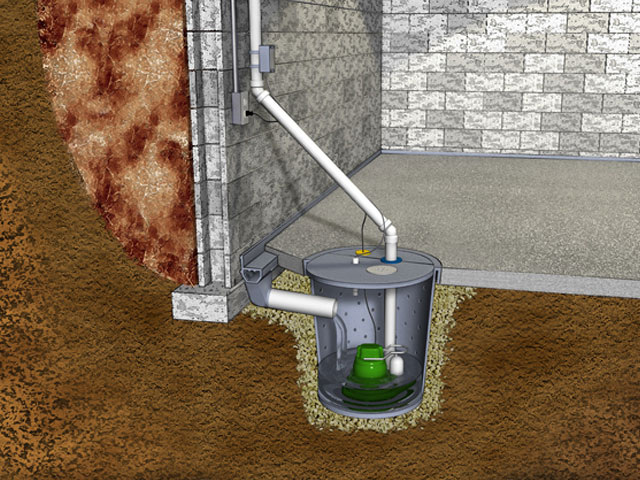Defending a home from water damage should be at the top of all homeowners to do list because even the tiniest bit of damage can cause thousands of dollars in repairs. A basement is especially vulnerable because of the damp conditions underground and because of fluctuating water tables caused by rain. The best way to avoid this area flooding in the house is by building in a basement sump pump.
Waterproofing a basement should be a multipronged approach because one way is never really enough to keep this room completely dry. Other ways, besides adding a sump pump, include strengthening walls with rubber polymers and making sure the roof drainage system empties far enough away from a foundation. Each repair to the home can save large amounts of money down the road.
Once these are seen to, it is time to make the best proofing decision, which is adding a sump pump to the room. How a sump pump system works is that it soaks up and pumps water from one area of the home to the outside far enough away from the foundation that the water will not return. Adding a sump pump to the basement area can be quite easy when taking the right steps.
The first thing to look for is the placement of where the pump is going to be put. This placement should usually be near a wall, but most importantly should be at the lowest point of a basement. Finding the lowest point may be difficult but is extremely important because water will use gravity to find its way here and settle. When this area is found, it should be chosen as the location of the pump.
Depending on what type of surface makes up the basement floor will factor into the difficulty of adding a sump pump. This is because it requires cutting a circular whole deep under the home where the pump is to be placed. Part of keeping this area by the wall is so the hole that is cut doesn’t interfere with or jeopardize the integrity of a foundation.
Finally, all a person has to do is run a hose from the basement sump pump that is lowered into the hole to the outside. Often cases, this is done by drilling a hole in the exit wall to an outside drainage area. One thing to be careful of is drilling through a weight bearing wall so that the integrity of the wall remains intact. Plug in the pump, test it out, and if all is well, the basement should not be in danger of flooding.
Waterproofing a basement should be a multipronged approach because one way is never really enough to keep this room completely dry. Other ways, besides adding a sump pump, include strengthening walls with rubber polymers and making sure the roof drainage system empties far enough away from a foundation. Each repair to the home can save large amounts of money down the road.
Once these are seen to, it is time to make the best proofing decision, which is adding a sump pump to the room. How a sump pump system works is that it soaks up and pumps water from one area of the home to the outside far enough away from the foundation that the water will not return. Adding a sump pump to the basement area can be quite easy when taking the right steps.
The first thing to look for is the placement of where the pump is going to be put. This placement should usually be near a wall, but most importantly should be at the lowest point of a basement. Finding the lowest point may be difficult but is extremely important because water will use gravity to find its way here and settle. When this area is found, it should be chosen as the location of the pump.
Depending on what type of surface makes up the basement floor will factor into the difficulty of adding a sump pump. This is because it requires cutting a circular whole deep under the home where the pump is to be placed. Part of keeping this area by the wall is so the hole that is cut doesn’t interfere with or jeopardize the integrity of a foundation.
Finally, all a person has to do is run a hose from the basement sump pump that is lowered into the hole to the outside. Often cases, this is done by drilling a hole in the exit wall to an outside drainage area. One thing to be careful of is drilling through a weight bearing wall so that the integrity of the wall remains intact. Plug in the pump, test it out, and if all is well, the basement should not be in danger of flooding.

 RSS Feed
RSS Feed